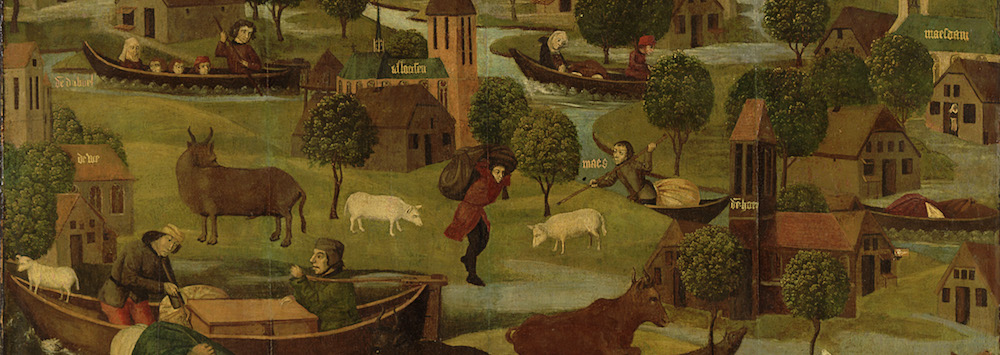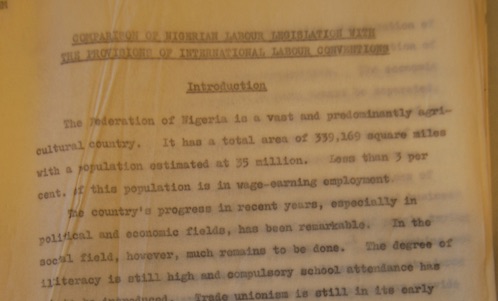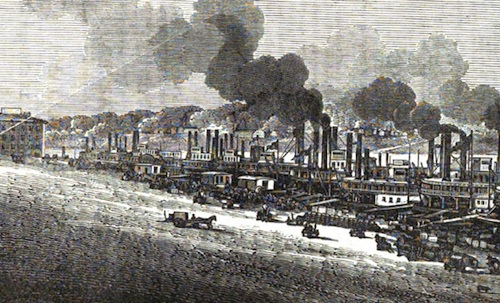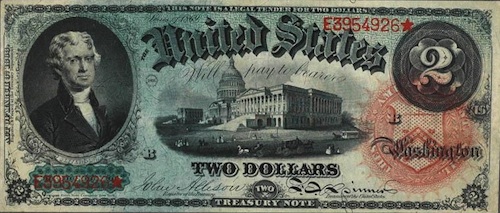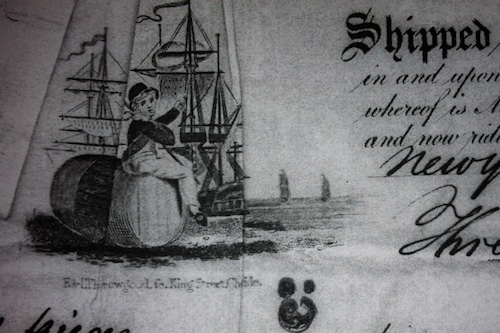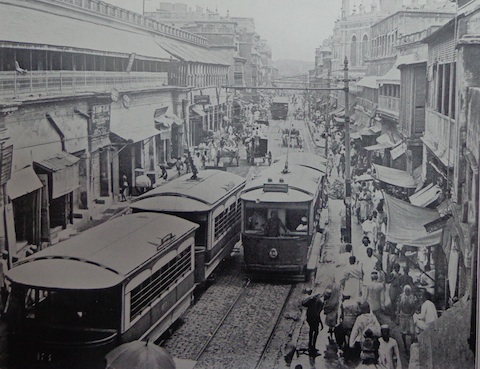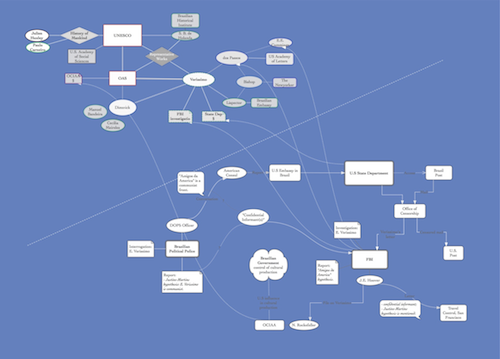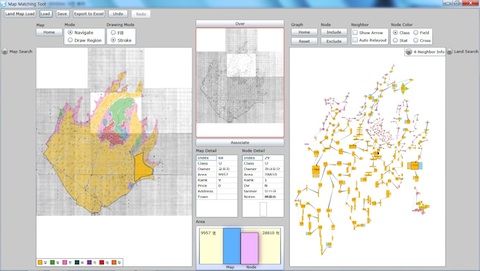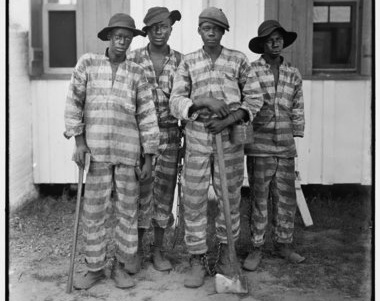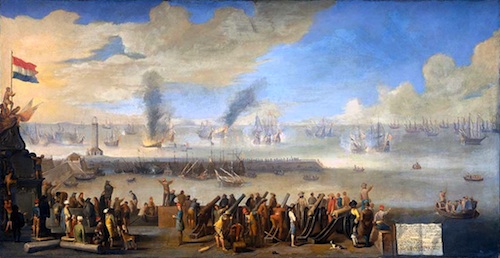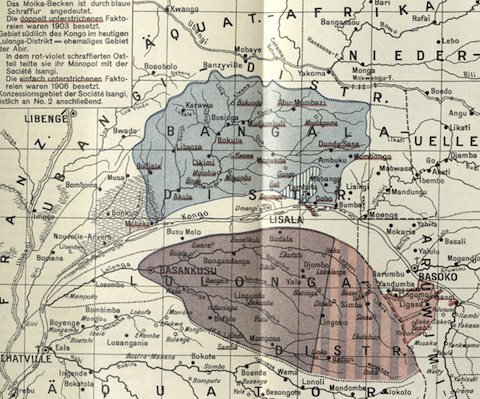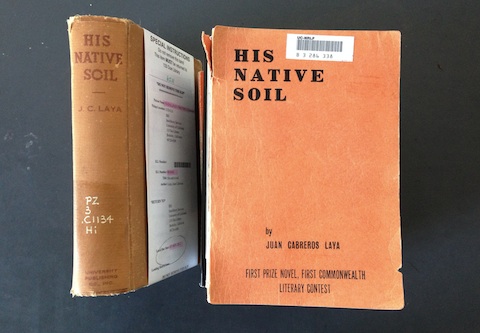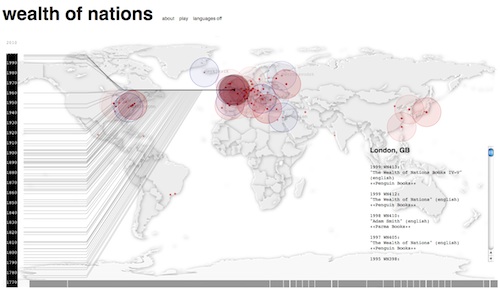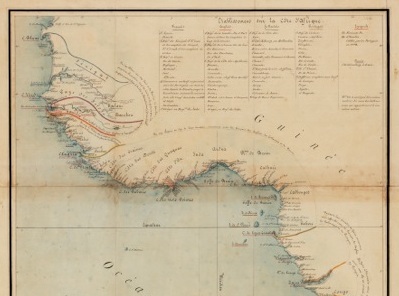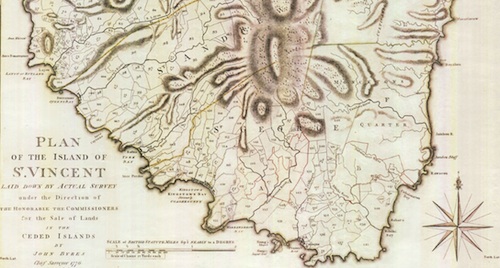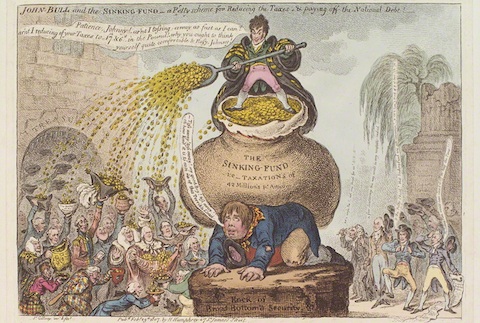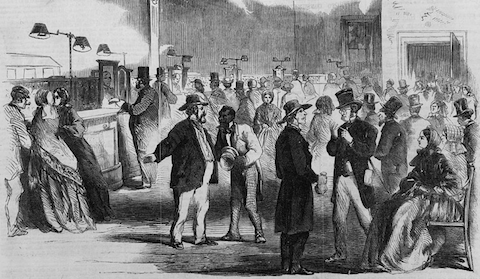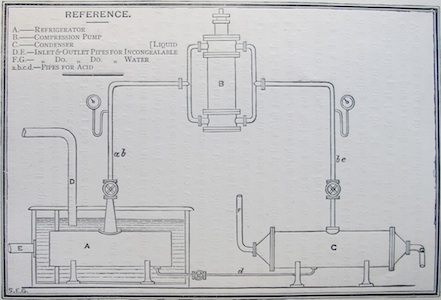Projects
"The ILO and the Political Economy of Wage Determination in Colonial Nigeria from the 1930s to the 1950s"
Although academic research has been conducted on the general influence of the International Labour Office (ILO) in the framing of colonial discourses about Africa, there are still gaps in knowledge. In my research (which will lead to an MA thesis and a journal/book chapter), I will analyse the influence of the ILO in the attempts of the British administration to determine wages in colonial Nigeria, and the impact on the economic life of wage-labour. The scope of the study is from the 1930s (following ILO’s Forced Labour Convention No. 29 adopted in 1930) until the 1950s when Nigeria was on the verge of attaining independence. The research will be based on primary records and publications from the ILO archive in Geneva, the UK National Archives, London, and the Nigerian National Archives, Ibadan. The history of wage-fixing in colonial Nigeria is understudied. Studying the wage-fixing process through discourse analysis of primary documents, and inferences from wage data could potentially nuance our understanding of the aim of the colonial enterprise. It could as well reveal the extent to which the colonial administration was sincere to the development and welfare agenda of the 1940s (and 50s). Read less » Abstract »Damilola Adebayo
The Graduate Institute of International and Development Studies, Geneva, Switzerland
damilola.adebayo@graduateinstitute.ch
"'A Foreign Code, Lacking in Principles of Individualism': Research on the Creation of a Nationwide Commercial 'Law for The River' in Louisiana, 1839-1858"
Historical treatments of the relationship between U.S. law and commerce in the pre-Civil War era often begin with common law-influenced court opinions by New England judges like Joseph Story. In 1825, however, in the U.S. Supreme Court's Steamboat Thomas Jefferson decision, Story actually restricted what he considered the most potent form of 'general common law' at the time, federal admiralty law, to seafront regions within the 'ebb and flow of the tide,' erasing the Ohio and Mississippi Rivers from coverage. Meanwhile, judges in common law states like Kentucky found English principles - protective as they were of private 'vested' property rights – inadequate to reach equitable outcomes in river trade disputes that entangled the interests of steamboat owners with creditors, passengers, and crew. Turning first from common law to chancery, steamboat lawyers in places like Cincinnati and Louisville began to litigate their clients' cases in Louisiana, where a civil law Code de Commerce based on continental principles was believed to balance the rights of claimants more efficiently. By the 1830s, the U.S. Supreme Court came onboard, taking notice that an 'occult tide' now extended beyond the Gulf of Mexico, up the Mississippi River, and onto the New Orleans levee. A national 'law for the river' was born. Through archival research in New Orleans, focusing on the unpublished case files of the Orleans Parish Commercial Court, this project aims to answer to what extent it was accurate to say that litigating in New Orleans really placed a great deal of antebellum U.S. commerce under, as one Cincinnati lawyer alleged, 'a foreign code' lacking in 'principles of individualism,' and whether this was in fact the feature that made Louisiana an attractive legal forum for steamboat people, engaged as they were in collective enterprises that otherwise spread the interests of bankers, boatwrights, forwarding merchants, floating crewmembers, and shorebound capitalists across space and time, on urban waterfronts from Pittsburgh to Liverpool and back again. Read less » Abstract »Matthew A. Axtell
Princeton University
"The Greenback State: Money, Power, and the Growth of Federal Authority during Reconstruction"
During the American Civil War, the federal government created a fiat currency and a national banking system that provided the country with its first real national currency. Within the span of a few short years, Americans experienced a dramatic transition from a country of a hundred different currencies issued by local banks to a nation of greenbacks issued under the authority of the U.S. government. This process not only unified the country economically, but brought the federal government into a new relationship with Americans and the national market. Unraveling how and why this centralization occurred presents a new picture of the development of federal power in the nineteenth century and provides another vantage point to survey the consequences of the Civil War for American history.
In this particular project, I will focus on the rise of federal authority to create, regulate, and authenticate this new national currency, all of which brought the government into a new relationship with financial markets and individual Americans after the Civil War. This grant will allow me to spend a month in Washington D.C. studying the administrative records of several agencies charged with managing this new system, and the papers of federal officials housed at the National Archives and the Library of Congress. I believe that these records will help me describe the new relationship between the government and the economy, and the politics it engendered. These funds will also support research into the wealth of pamphlets and newspapers generated by the greenback controversies of the late 1860s and 1870s. I will revisit this material anew to understand how the greenbacks fostered new political alignments, and how class tensions over national monetary policy contributed to federal power after the war. In short, my goal will be to explore how the power to create and control the nation's money transformed the federal government and American political economy in the postwar era. Read less » Abstract »Michael T. Caires
University of Virginia
"Commodification, Slavery, Credit, and the Law in the Lower Mississippi River Valley, 1780-1830"
n 1818, just one year after Mississippi achieved statehood, Philadelphia merchants pushed their regional interests by filing a lawsuit in the Supreme Court of that state against a Natchez client. Despite being "contrary to Mississippi law," the merchants claimed that, on the basis of "the customs of merchants in Philadelphia," they had the right to collect interest on an account, even if the principal had not been paid. The Mississippi jury awarded the case to the plaintiffs. The need to cross the border from one legal sphere into another and alter an already codified rule of law in favor of an outside custom was not new; on-going struggles over alternative, autonomous, and "indigenous" ways of doing business had long characterized the Atlantic's heterogeneous mercantile communities. What was new appeared in the form of a more complicated political and economic context. Beginning in the 1790s, districts along the Delta were rapidly gaining a share in the British cotton market. The Louisiana Purchase of 1803 had ushered in a rapid succession of settlers and new investors. The influx of British capital in the 1820s and 1830s further expanded investment in cotton. These events transformed the Lower Mississippi Valley from a series of remote outposts into vital exporting enclaves. They also created an increased demand for larger amounts of working capital and forced economic actors to contend with an ever-widening assortment of legal politics.
This study examines how Atlantic mercantile communities set-up and maintained regulatory structures for the exchange of cotton and credit in a de-centralized economy by tracing the networks which directly tied credit-granting regions with cotton-producing districts. The project spans the period between the 1790s and 1820s, focusing on the cities of London, New York, and Philadelphia, where capital accumulation was the strongest, and the plantations districts of Natchez, Mississippi and East Feliciana Parish, Louisiana. The War of 1812, over speculation in cotton, as well as the impact of British investment in the 1820s were instances by which various groups vied for control. In doing so, they re-made routines inherent in trade. They also re-set the notion of mercantile authority. I explore these changes in merchants' arbitration proceedings, in the territorial and state records, as well as plantation mortgages, manuscripts of prominent firms, proceedings from various Chambers of Commerce and individual mercantile accounts. I hope to uncover a regulatory system not imposed "from above," but one that emerged out of the interactions between merchants in multiple jurisdictions responding to globalizing pressures and the internal dynamics of particular places. Read less » Abstract »Elbra David
University of California – Irvine
"Sheffield Artisans 1624-1815: Training, the labour market and popular politics"
This project will compile a large database of apprenticeship indentures of light metal industry workers in Sheffield between 1624-1815. These will be used to investigate early modern labour markets and the dynamics of human capital formation. Through nominal linkage this study will provide a crucial insight into the social networks mobilized in accessing formal training. This project also looks at the intense radicalism of the Sheffield artisanate in response to the French Revolution and the ways in which local struggles over the role of the guild in regulating apprenticeships influenced popular politics. Read less » Abstract »Arthur Downing
University of Oxford
arthur.downing@all-souls.ox.ac.uk
"The Hidden Politics of Regulatory Change: Judicial Deference, Administrative Authority, and the Re-Ordering of the American Financial System, 1968-1988"
My project examines the role of courts and administrative agencies in bringing about deregulation in modern American political history. Extant narratives on deregulation emphasize the influence of the Presidency and Congress. But I argue that scholars focused on high-profile initiatives like Sen. Kennedy's subcommittee hearings and President Reagan's executive orders have missed the more subtle, less visible means by which conservative policymakers tried to chip away at the regulatory state. They did so not only with legislative "big bangs" and decrees that centralized presidential control over regulatory affairs, but by capitalizing on new administrative law doctrines so that the now Republican-controlled agencies would have greater discretion to un-do the statutes of the historical past. This pattern was particularly evident in the case of financial regulation. Reagan appointees on the DC Circuit like Robert Bork, Ken Starr, and Antonin Scalia appropriated the highly-deferential Chevron decision to ensure that the Federal Reserve could bend the meaning of the Glass-Steagall and Bank Holding Company Acts, and let commercial banks into speculative forms of securities trading (from which they had been barred since the New Deal). By focusing attention on the judicial and administrative mechanisms used to bring about regulatory change, my project aims to expand how scholars think about the revival of "freer markets" in recent American politics. Read less » Abstract »Erik Erlandson
University of Virginia
eme6vx@virginia.edu
"Overseeing the State: Lawyers and the Rebirth of Executive Power in the 1980s"
Today, the American Presidency sits at the epicenter of regulatory policy. Through departments like the Office of Management and Budget (OMB) and the Office of Information and Regulatory Affairs (OIRA), presidents directly control the panoply of federal agencies that issue rules and regulations for private conduct. One need not look further than some of last year's headlines for evidence of regulations that bear the mark of the chief executive. "Obama Carbon Rules to Cut Coal-Related Jobs." "Obama to Ease Immigration Rules on Millions of Undocumented." "How Wheeler's 'Net Neutrality' Became Obama's 'Public Utility.' " My dissertation—"Overseeing the State: Lawyers and the Rebirth of Executive Power in the 1980s"—asks how the presidency assumed managerial powers over the regulatory process. It unveils the critical role of the legal profession, in particular two organizations—the organized bar's Administrative Law Section and a little-known agency called the Administrative Conference of the United States (ACUS)—which provided the constitutional and intellectual framework that legitimized executive control of the regulatory state. The work of the bar and the conference supplied the legal foundation for Reagan's executive order 12,291, the first attempt by a president to dictate the substance of administrative decisions, which has been extended or tweaked by every subsequent administration. Regardless of party, each has agreed that executive management of the administrative state is both politically desirable and legally permissible. My project explains how these ideas—which are still central to American governance—became legally and politically authoritative in the late twentieth century. Read less » Abstract »Erik Erlandson
University of Virginia
eme6vx@virginia.edu
"Bazaar Capitalism in South Asia: Capitalist, Merchants, and the 'Barabazar' of Calcutta c. 1890-1947"
Urban bazaars or market places have been at the center of economic and urban life in South Asia. Yet, the roles played by such bazaars as sites of accumulation, commerce and societal interactions have been largely neglected. This neglect I believe has occluded our understanding of the causes and motivations underlying social, political and economic attitudes of Indian merchants and capitalists, who have been intimately associated with such bazaars. Through my research I hope to demonstrate that attitudes and practices perfected in the bazaars provide keys, which can help make legible certain aspects of Indian capitalist practices like the logic(s) of their investments in property, print capitalism, philanthropy, and their social and political attitudes. In my project therefore, I take the under-theorized and under-explored urban bazaar, as the central object of analysis, with two aims. First, to explore what I call "bazaar capitalism" or the close, tangled and constitutive relationship between urban bazaars and Indian merchants, especially at a time when a host of Indian capitalists (or oligarchs) emerged from these bazaars in early 20th century. The second, to undertake a historical study of urban bazaars themselves, with one of the central animating question being how the recognition of material spatiality of bazaars revises our understanding of Indian business practices and politics, lived urban environments and urban economies. In my research, I take the Barabazar of Calcutta between 1890 and 1940s as my case study, which has been at the apex of the bazaar economy of eastern India over the last two centuries and from which several of the most prominent Indian capitalists have emerged in the twentieth century. Read less » Abstract »Gaurav Garg
New York University
gcg257@nyu.edu
"Books for Global and National Identities: Tracing Networks for a Brazilian Perspective on UNESCO’s Literary Projects"
This work maps the context of international publishing and surveillance of literature in the Cold War, focusing on Brazil and its foreign relations. Beyond the studies of national states' influence on cultural production, it considers the role of the literature in transnational institutions – particularly the United Nations – based on broad archival research in Europe and North and South Americas. It aims at assessing the transition between two mid-twentieth century transnational publishing efforts: From the World War II Ally campaign for books as weapons in the war of ideas to the postwar UNESCO project for books for peace, or mutual understanding. Inter-American police files show wartime surveillance apparatus was connected to cultural production ones, and were later the basis for Cold War political, cultural and economic endeavors in the Americas. Meanwhile, UNESCO documentation regarding its literary projects reveal a contrasting relation between national identities and one-world narratives. Authors' letters and press material also show a rapid appropriation of UN ideals into Brazilian political culture, and the UNESCO editions of novels suggest internationalism was incorporated in Brazil's search for a national identity. The argument explored in this research is that these tensions shed light on the role of culture in foreign policy and vice versa, and that financing art was an increasingly global enterprise of public and private organizations, from the Organization of American States to Standard Oil, involving geopolitical interests as well as literary scholars with large-scale ideals. Read less » Abstract »Maria Gatti
Harvard University
"Another Type of Rationality: the Principle of Land Taxation of the Korean Empire"
Major tax sources of traditional East Asia were the population and land. In particular, in Korea, China, Japan, the three countries created nationwide land registers at least 1,000 years ago. In this study, I want to find the Korean traditional principle of land taxation through comparing Kwangmu land registers(????) made by the Korean Empire in the 19th century with the modern land registers of the Japanese Colonial period by utilizing a software named 'JigsawMap' which I developed with HCIL.
During the Colonial period, the government enforced a guideline for land investigation and applied it across the country. On the other hand, the Korean Empire did not use overt rules and technicalities. Nevertheless, I could determine its underlying principles and institutions through my research. The Korean Empire adjusted tax burden taking land productivity into account during land survey. Area recorded in the Kwangmu land registers was smaller than actual one, shows different rate of reduction by land types.
At the same time, there were distinctions by regions. I compared two provinces; one is Ch'ungch'?ng province, which could ship taxation by sea, the other is Ky?ngsang province that was far from the capital and had to use an overland route only. Through my analysis, it was revealed that the burden of land tax was much lighter in Ky?ngsang province. Assessments of area and grade were undervaluated compared with Ch'ungch'?ng province. I presume this was the result of difference in inter-regional of tax transportation costs.
The Land taxation system in the Korean Empire was similar with the Chos?n dynasty's one. They stuck by those principles; be they different assessments according to the value of crops produced in the land, be they equal total tax burden in each region. It was the governing philosophy of the dynasty that aimed at Neo-Confucian equality among the people across the country. Flexibility in diversity, equality in flexibility was their indigenous rationalities. I think it can be a clue to understand other pre-modern state's tax system. Read less » Abstract »Sora Kim
Seoul National University
sora1988@snu.ac.kr
"Convict Lease and Labor Demand in the American South"
After the Civil War, several Southern states leased out their prison populations as laborers for private businesses, ranging from cotton farms and lumber mills to coal mines and manufacturing plants. Nearly all the convict laborers were black men, and many served long sentences for minor or even trumped-up charges such as vagrancy, playing cards, or selling crops after dark. As the program was driven by economic interests, I am investigating the extent to which arrests responded to labor demand in Alabama and Mississippi. Counties' arrest rates will be compared to periods of peak labor demand—during the cotton harvest and after labor shocks in the Alabama steel industry. Early results show that arrests increase dramatically just prior to the peak cotton harvest. I will also investigate the factors affecting the degree to which counties and sheriffs abused their power within the system, measured in terms of their responsiveness to labor demand. Read less » Abstract »Tim Larsen
University of Colorado
https://sites.google.com/site/timlarsencolo
"The Economics of Affection: Commerce and Community in Livorno and the Anglophone Mediterranean, 1591-1796"
In a bid to transform the harbor of Livorno into a military stronghold and bustling center of global trade, the Medici Grand dukes made the city a laboratory for commercial and religious liberalism, extending freedom of worship and favorable trading conditions to Sephardic Jews, English Protestants, and all manner of economically valuable "heretics." Though the Medici regime struggled to mediate the squabbles of its minority populations and balance its liberal policies against the demands of the Inquisition, for at least two centuries Livorno's denizens prospered and its unique social politics made the city both an oddity and a marvel against the backdrop of a mercantilist, confessionalist Europe. The English in Livorno, initially an enclave of privateers and minor traders, became a settled community of wealthy merchants and their families. They acquired property, chose Italian godparents, and quarreled with or befriended their neighbors. My project explores how life in Livorno transformed their identities, national allegiances, and local hierarchies of power. The British Leghorn merchants chafed against the monopolistic grasp of the Levant and East India Companies and often bucked direct control from London by electing their own consuls and settling their disputes in local courts. The Anglo-Livornese were wary collaborators in the expanding networks of British companies and colonies, yet their phenomenal financial successes, as well as cunning design and efficient management of Livorno itself drew the interest of English politicians and political economists seeking models for their own imperial outposts, such as the failed colony at Tangier. My research asks what the semi-outsider status of the Leghorn merchants can tell historians about early modern imperialism, trade, and the self-fashioning of commercial identities in Britain and the Mediterranean. Using English and Italian economic pamphlets, merchant letters, account books, and traces of material life from historical sites such as cemeteries, my project recreates the way the English and later British shaped and were shaped by Livorno's pluralistic free port society, in turn helping to define it as a modern marvel of early modern political economics. Read less » Abstract »Lisa Marie Lillie
Washington University in St. Louis
lmlillie@wustl.edu
"Blood Rubber: The Effects of Labor Coercion on Development and Culture in the DRC"
King Leopold's Congo Free State is infamous for its coercive and exploitative labor practices, particularly in the extraction of rubber. Between 1892 and 1906, Leopold divided parts of DRC into concessions that were granted to private companies to extract rubber. These companies used violence and coercion to force people to collect rubber. My co-author, Sara Lowes (Harvard University), and I examine the long term effects of exploitative institutions and labor coercion on development outcomes in DRC today. First, we use a geographic regression discontinuity design to demonstrate that those areas inside former rubber concessions have worse development outcomes today across a variety of measures. Second, we examine various potential channels for the persistence of these effects. We find evidence of worse public goods provision at the local level in former concessions, suggesting that local institutions were undermined during the rubber concession period. As a next step, we are returning to the former concession areas to conduct detailed surveys and lab-in-the-field experiments to better understand the institutional and cultural channels through which historic events can have persistent effects on development. Read less » Abstract »Eduardo Montero
Harvard University
emontero@fas.harvard.edu
"Nation and Repatriation: Philippine Commonwealth Nationalism and the Rise of the Filipino Realist Novel in English, Juan C. Laya's His Native Soil (1940)"
Part of a larger dissertation study on the literary evolution of the English Filipino novel in the context of the Philippines' historical experience with global finance capital, this project focuses on the Commonwealth period (1935-1946), a ten-year transition from U.S.-colonial rule to formal independence. It examines a particular episode when economic and literary discourse intersect: the awarding of First Prize to Juan C. Laya's His Native Soil (1940), one of the earliest Filipino novels in English, at a government-sponsored literary contest which the state saw as integral to its program of national development. Combining close reading of Laya's novel with analyses of Commonwealth-era documents on economic reforms, this project shows how the transition government drew its most compelling expression of national self-determination not in the figure of the local nationalist, but in the figure of the repatriate, of the Filipino returning from abroad. The incipient realism of His Native Soil, I argue, lies in the way it renders the story of repatriation to register the state's ambivalent feelings around U.S.-directed reforms, in particular those concerning the liberalization of Philippine commerce as a condition for the granting of political independence. More than a figure for migratory return, "repatriation" under the Commonwealth came to define a distinct nationalist imaginary, one that was structured by the desire to retrieve from the foreign what the Philippines viewed as native and proper to it — dispersed peoples, political agency, money — even as such transactions continuously threatened to revise the meanings of "native" and "foreign." Read less » Abstract »Paul Nadal
University of California - Berkeley
pjnadal@berkeley.edu / www.paulnadal.com
"An Inquiry into the Diffusion of Dr. Adam Smith's The Wealth Of Nations"
This project is a quantitative history of Adam Smith's The Wealth of Nations, that follows the diffusion of Smith's ideas across time, space and language. Using various methods of data visualization, the publication history of Smith's book will be tracked globally and related to the regional emergence of specific economic concepts. These global and local 'data narratives' will be ultimately displayed as a series of physical, interactive installations. Read less » Abstract »Robert Pietrusko
Harvard University
rgp@metalab.harvard.edu
"Supplying the Slave Trade: How Europeans Met African Demand for European Manufactured Products, Commodities and Re-exports: 1670-1790"
My project examines how European slave-ship outfitters met African demand for European products and re-exports, which was varied, use-specific and notoriously hard to foretell. Although Europeans forcibly transported 12.5 million Africans over the duration of the slave trade, the purchasing of slaves and the loading of slave ships happened incrementally: With every transaction Europeans exchanged an assortment of goods for an assortment of slaves. But when it came to trading, both actors on the ground and writers in Europe complained about "the fanciful and various Humours of the Negroes," as 1735 Guinea travel-writer John Atkins put it, "who make great demands one Voyage for a Commodity, that perhaps they reject next." My project looks at this problem of market coordination as European outfitters assembled a global assortment of merchandise in a world of highly imperfect information. It also examines how private traders competed against state companies without the institutional infrastructure of the African fort system. Lastly, my project considers the persistence of assortment bargaining over the duration of the slave trade, despite its apparent inefficiencies. Read less » Abstract »Anne Ruderman
Yale University
anne.ruderman@yale.edu
"The male occupational structure of northwest England, c. 1600 – 1851"
The Industrial Revolution has long been associated with a structural transformation of the English economy - at the accession of Elizabeth I a large majority of the English population worked in agriculture, while by the Great Exhibition of 1851 only a minority did. However, only recently has this transformation begun to be robustly evidenced and precisely tracked. My project contributes to this effort through an analysis of approximately 140000 occupational observations from the northwest of England, a region long considered at the vanguard of the Industrial Revolution. Drawn from local court documents, this occupational data will be used to estimate the occupational structure of the northwest throughout the early modern period. Particularly high volumes of data for select years will be used to produce detailed maps of the occupational geography of the northwest in the 17th, 18th, and 19th centuries, and to analyze the short run dynamics of occupational structures in those periods. These results will allow for more a accurate and precise understanding of the development of the northwest throughout the early modern period, as well as for a re-evaluation of the dynamics of the regional economies in early modern England. Read less » Abstract »Tim Rudnicki
University of Cambridge
"Role of the Caribbean in the development of British cartography and the map market in the eighteenth century"
At the end of the Seven Years War in 1763, France ceded Grenada, St. Vincent, Tobago, and Dominica to Great Britain. These islands represented lucrative economic opportunities for British officials. But war had ravaged the islands' towns, and angered French residents and indigenous Caribs alike were loath to accept British rule. As Samuel Holland and others surveyed North America, the Lords Commissioners for Trade and Plantations sent John Byres (d. 1793) to execute a survey of the Ceded Islands in what may have been part of an organized, but as of the present, largely undocumented global survey of the British Empire. His beautiful and exacting charts, finally published in 1776, constituted one of Britain's first large scale, organized attempts at long-term economic planning in the West Indies. Nonetheless, on St. Vincent, the maps and plans likely contributed to the island's collapse and the ignominious downfall of its governor, Vincent Morris. Byres, with his specialized expertise in economic surveying, was appointed one of the East India Company's engineers and sent to India, where he was captured by the French, and later used his West Indian training to create similar charts of Indian settlements. Read less » Abstract »Benjamin Sacks
Princeton University
bsacks@princeton.edu
"Historical Public Deleveraging Episodes: Political And Central Bank Strategies"
With Western economies running record-level public debt-GDP ratios after the global financial crisis, the challenge to reduce debt volumes is becoming more pressing. But academic discussions about adequate strategies to proceed are often inconclusive, and ahistorical. This project will look to economic history to offer recommendations for preferred deleveraging strategies, with recourse to four European deleveraging case studies between 1820 and 1959 in Italy, France and the United Kingdom - each of which achieved a decline of debt-GDP ratios of more than 50 per cent within 15 years or less. Both quantitative and qualitative evidence from archives at the Banque de France, Bank of England, Banca d'Italia and other European national archives will be used to draw implications for today's challenges, with a particular focus on the cooperation between treasuries, economics ministries and central banks. Read less » Abstract »Paul Schmelzing
Harvard University
schmelzing@fas.harvard.edu
"Bonds of War: The Marketing of Union Debt During the American Civil War"
The American Civil War cost the federal government $3.2 billion; much of the money was raised from the sale of Union bonds. My project examines how these bonds were marketed and sold and through this, what version of the war the Union public was willing to buy and buy into. This project looks particularly at the bond agents—the large financial house of Jay Cooke & Company, their subcontracting agencies and the thousands of traveling agents who canvassed far and wide to sell their wares. Equally important is the language in which they marketed these financial instruments, especially as financiers utilized rhetoric that instilled a faith in capitalism constructed around the concepts of Union, democracy, free labor, and the rewards (personal and national) of a centralizing economy. Furthermore, the marketing of such securities crossed the Atlantic to buyers in England, France, Germany, and the Netherlands revealing the lengths to which Cooke and his partners exerted their influence to reinforce faith and confidence in the federal government abroad—especially among future immigrant populations. More than anything, my dissertation is about marketing. Newspapers served as the primary point of advertisement for salesmen and the publication of subscriber names; articles also listed the quantities sold by region, which became a clear demonstration of loyalty for many within the northern public. Once more, these bonds were made available with payment plans and in denominations as small as $50, enabling a wide array of investors. In essence, the democratic messaging of bond sales conveniently made this potential monetary windfall seem a patriotic duty. However, above all else, Civil War bond markets reveal the reconstitution of the individual to the American state and represent a watershed moment in American financial history. Read less » Abstract »David K. Thomson
University of Georgia
thomsond@uga.edu
"From Field to Freezer: Refrigerated Transportation in the British Empire, c. 1870-1890"
In 1879, the first successful shipment of frozen meat from colonial Australia reached London on board the S.S. Strathleven, the cargo maintained cool by super-chilled ammonia gas circulating through the insulated hold of the ship throughout the duration of the voyage, some ten thousand miles by sea. This voyage ushered in a new era in production, transportation, and consumption for imperial Britons and colonial producers. By the early years of the twentieth century, frozen meat had become a significant source of nourishment for metropolitan populations, as well as a cornerstone of colonial economies. The economics, infrastructure, and logistics of the trade all relied on the technologies of artificial refrigeration, without which the ovine surplus of Australasia could not have satisfied the Britain’s demand for more mutton and lamb, nor could have metropolitan markets satisfied the pressing need for increased profitability in the colonial pastoral industry. This project explores the development and implementation of refrigerating technologies, examining trade documents and the records of engineering plans to understand the growth of the network in refrigerated transportation and storage that arose in the late nineteenth century. This research is part of a larger dissertation project that explores the circulating and significance of British breeds of livestock in the British Empire. Read less » Abstract »Rebecca J Woods
MIT
rjwoods@mit.edu
Center for History and Economics
Faculty of Arts and Sciences
Harvard University
(c) 2025 Center for History and Economics

